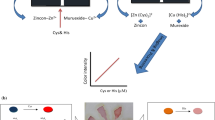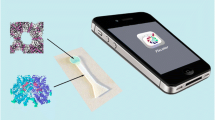Abstract
Iron is an important micronutrient involved in several mechanisms in the human body and can be an important biomarker. In this work, a simple and disposable microfluidic paper-based analytical device (µPAD) was developed for the quantification of iron in urine samples. The detection was based on the colorimetric reaction between iron(II) and bathophenanthroline and the reduction of iron(III) to iron(II) with hydroxylamine. The developed µPAD enabled iron determination in the range 0.07–1.2 mg/L, with a limit of detection of 20 µg/L and a limit of quantification of 65 µg/L, thus suitable for the expected values in human urine. Additionally, targeting urine samples, the potential interference of the samples color was overcome by incorporating a sample blank assessment for absorbance subtraction. Stability studies revealed that the device was stable for 15 days prior to usage and that the formed colored product was stable for scanning up to 3 h. The accuracy of the developed device was established by analyzing urine samples (#26) with the developed µPAD and with the atomic absorption spectrometry method; the relative deviation between the two sets of results was below 9.5%.
Graphical abstract







Similar content being viewed by others
Data availability
Not applicable.
Code availability
Not applicable.
References
Linus Pauling Institute (2016) Iron | Linus Pauling Institute | Oregon State University. https://lpi.oregonstate.edu/mic/minerals/iron. Accessed 7 Sep 2020.
Nakatani S, Nakatani A, Ishimura E, Toi N, Tsuda A, Mori K, Emoto M, Hirayama Y, Saito A, Inaba M. Urinary iron excretion is associated with urinary full-length megalin and renal oxidative stress in chronic kidney disease. Kidney Blood Press Res. 2018;43:458–70. https://doi.org/10.1159/000488470.
Marshfield Labs Iron, Urine (FEU). https://www.marshfieldlabs.org/sites/ltrm/Human/Pages/22804.aspx. Accessed 7 Sep 2020.
Iron, Urine. http://www.labnet.health.nz/testmanager/index.php?fuseaction=main.DisplayTest&testid=284. Accessed 17 Sep 2020.
Iron, Urine - NMS Labs. https://www.nmslabs.com/tests/2430U. Accessed 17 Sep 2020.
Petti CA, Polage CR, Quinn TC, Ronald AR, Sande MA. Laboratory medicine in Africa: a barrier to effective health care. Clin Infect Dis. 2006;42:377–82. https://doi.org/10.1086/499363.
McNerney R. Diagnostics for developing countries. Diagnostics. 2015;5:200. https://doi.org/10.3390/DIAGNOSTICS5020200.
Almeida MIGS, Jayawardane BM, Kolev SD, McKelvie ID. Developments of microfluidic paper-based analytical devices (μPADs) for water analysis: a review. Talanta. 2018;177:176–90. https://doi.org/10.1016/J.TALANTA.2017.08.072.
Martinez AW, Phillips ST, Butte MJ, Whitesides GM. Patterned paper as a platform for inexpensive, low-volume, portable bioassays. Angew Chem. 2007;119:1340–2. https://doi.org/10.1002/ange.200603817.
Jiang X, Fan ZH. Fabrication and operation of paper-based analytical devices. Annu Rev Anal Chem. 2016;9:203–22. https://doi.org/10.1146/annurev-anchem-071015-041714.
Martinez AW, Phillips ST, Whitesides GM, Carrilho E. Diagnostics for the developing world: microfluidic paper-based analytical devices. Anal Chem. 2010;82:3–10. https://doi.org/10.1021/ac9013989.
Paper microfluidic devices : a review 2017 - Elveflow. https://www.elveflow.com/microfluidic-tutorials/microfluidic-reviews-and-tutorials/paper-microfluidic-devices-a-review-2017/. Accessed 13 Dec 2018.
Birch NC, Stickle DF. Example of use of a desktop scanner for data acquisition in a colorimetric assay. Clin Chim Acta. 2003;333:95–6. https://doi.org/10.1016/S0009-8981(03)00168-2.
Ramdzan AN, Almeida MIGS, McCullough MJ, Kolev SD. Development of a microfluidic paper-based analytical device for the determination of salivary aldehydes. Anal Chim Acta. 2016;919:47–54. https://doi.org/10.1016/j.aca.2016.03.030.
Yiannikourides A, Latunde-Dada G. A short review of iron metabolism and pathophysiology of iron disorders. Medicines. 2019;6:85. https://doi.org/10.3390/medicines6030085.
Ems T, Lucia KS, Huecker MR (article editor) (2019) Biochemistry, Iron Absorption. StatPearls Publishing Bookshelf ID:NBK448204
Moniz T, Bassett CR, Almeida MIGS, Kolev SD, Rangel M, Mesquita RBR. Use of an ether-derived 3-hydroxy-4-pyridinone chelator as a new chromogenic reagent in the development of a microfluidic paper-based analytical device for Fe(III) determination in natural waters. Talanta. 2020;214:120887. https://doi.org/10.1016/j.talanta.2020.120887.
Ogawa K, Kaneta T. Determination of iron ion in the water of a natural hot spring using microfluidic paper-based analytical devices. Anal Sci. 2016;32:31–4. https://doi.org/10.2116/analsci.32.31.
Shrivas K, Monisha KT, Karbhal I, Kurrey R, Sahu B, Sinha D, Patra GK, Deb MK, Pervez S. Smartphone coupled with paper-based chemical sensor for on-site determination of iron(III) in environmental and biological samples. Anal Bioanal Chem. 2020;412:1573–83. https://doi.org/10.1007/s00216-019-02385-x.
Ferreira FTSM, Mesquita RBR, Rangel AOSS. Novel microfluidic paper-based analytical devices (μPADs) for the determination of nitrate and nitrite in human saliva. Talanta. 2020;219:121183. https://doi.org/10.1016/j.talanta.2020.121183.
Hirayama T, Nagasawa H. Chemical tools for detecting Fe ions. J Clin Biochem Nutr. 2017;60:39–48. https://doi.org/10.3164/jcbn.16-70.
Marczenko Z, Balcerzak M. Separation, preconcentration, and spectrophotometry in inorganic analysis. 1st ed. Amsterdam: Elsevier Science; 2000.
Machado A, Mesquita RBR, Oliveira S, Bordalo AA. Development of a robust, fast screening method for the potentiometric determination of iodide in urine and salt samples. Talanta. 2017;167:688–94. https://doi.org/10.1016/j.talanta.2017.03.017.
APHA, AWWA, WEF (1998) Standard Methods for the Examination of Water and Wastewater, Editors: Clesceri LS, Greenberg AE, Eaton AD, 20th ed. Washington, DC, Section 3500-Fe, p.440-447.
Santos IC, Mesquita RBR, Bordalo AA, Rangel AOSS. Iodine speciation in coastal and inland bathing waters and seaweeds extracts using a sequential injection standard addition flow-batch method. Talanta. 2015;133:7–14. https://doi.org/10.1016/j.talanta.2014.01.025.
Currie LA. Nomenclature in evaluation of analytical methods including detection and quantification capabilities (IUPAC Recommendations 1995). Pure Appl Chem. 1995;67:1699–723. https://doi.org/10.1351/pac199567101699.
Funding
This work was supported by National Funds from FCT—Fundação para a Ciência e a Tecnologia through project UIDB/50016/2020. F.T.S.M. Ferreira received grant SFRH/BD/144962/2019 from FCT—Fundação para a Ciência e a Tecnologia.
Author information
Authors and Affiliations
Contributions
Conceptualization—Raquel B. R. Mesquita. Methodology—Francisca T. S. M. Ferreira, Karina A. Catalão. Validation—Francisca T. S. M. Ferreira. Formal analysis—Karina A. Catalão, Francisca T. S. M. Ferreira. Investigation—Karina A. Catalão, Francisca T. S. M. Ferreira. Resources—António O. S. S. Rangel. Writing—original draft—Francisca T. S. M. Ferreira. Writing—review and editing—Raquel B. R. Mesquita, António O. S. S. Rangel. Project administration—Raquel B. R. Mesquita, António O. S. S. Rangel. Funding acquisition—António O. S. S. Rangel.
Corresponding author
Ethics declarations
Ethics approval
The urine samples involved in this work were blind in-house samples, with no identification nor any information required or register, obtained from voluntary participants with informed consent. There was no association with a clinical trial.
Consent to participate
Not applicable.
Conflict of interest
The authors declare no competing interests.
Additional information
Publisher’s note
Springer Nature remains neutral with regard to jurisdictional claims in published maps and institutional affiliations.
Supplementary Information
Below is the link to the electronic supplementary material.
Rights and permissions
About this article
Cite this article
Ferreira, F.T.S.M., Catalão, K.A., Mesquita, R.B.R. et al. New microfluidic paper-based analytical device for iron determination in urine samples. Anal Bioanal Chem 413, 7463–7472 (2021). https://doi.org/10.1007/s00216-021-03706-9
Received:
Revised:
Accepted:
Published:
Issue Date:
DOI: https://doi.org/10.1007/s00216-021-03706-9




